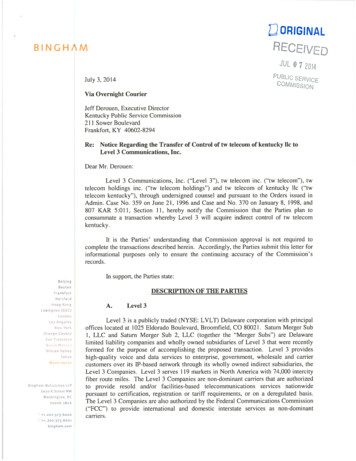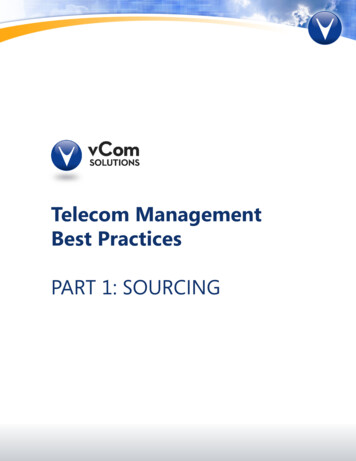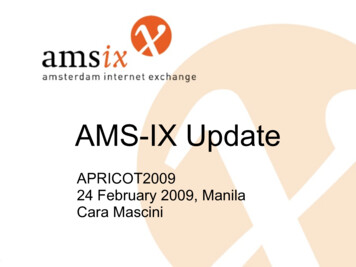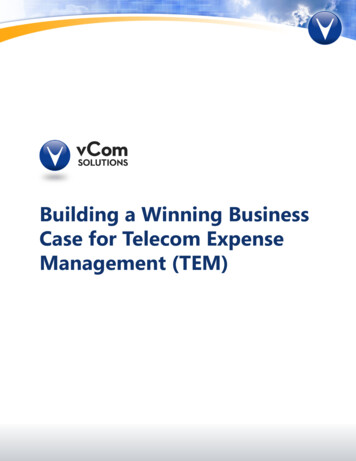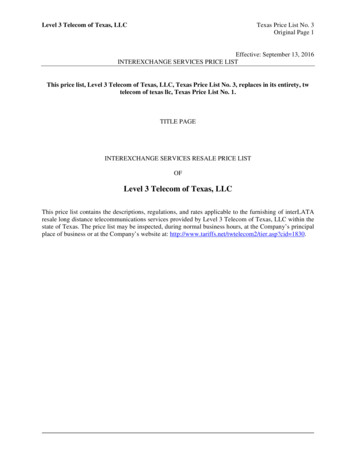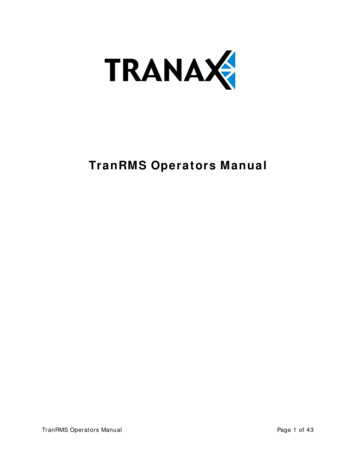
Transcription
Partnering upHow telecom operatorscan expand their partnerchannel for IT/digitalgrowth in B2B
ContactsDubaiJad HajjPartner 971-4-436-3000jad.hajj@strategyand.ae.pwc.comChady SmayraPartner chilles DrettasPrincipal comAbout the authorsJad Hajj is a partner with Strategy& MiddleEast, part of the PwC network. Based in Dubai,he is a member of the technology, media,telecommunications, and digital practice in theMiddle East. He specializes in helping telecomoperators and technology providers developwinning strategies and build distinctive digitalcapabilities. He has particular expertise incorporate and business-to-business strategy,along with digitization and innovation.Chady Smayra is a partner with Strategy&Middle East. Based in Dubai, he is a memberof the technology, media, telecommunications,and digital practice in the Middle East. Hehas more than 22 years of experience ininformation and communications technologies(ICT) focused on the telecoms and technologysectors. He specializes in growth strategy,digital transformation, mergers and acquisitions,technology ventures and digital business models,and performance turnaround programs.Achilles Drettas is a principal with Strategy&Middle East. Based in Dubai, he is a member of thetechnology, media, telecommunications, and digitalpractice in the Middle East. He works with telecomoperators and technology providers to expand theirIT/digital business with enterprises. He brings deepexpertise in corporate and business strategies,governance and operating models, and B2B salesand marketing transformation.
EXECUTIVE SUMMARYTelecom operators have been expanding their offerings to capitalize on the region’s largeIT/digital services market, worth around US 52 billion in the Middle East and Africa in2020, according to IDC. A major challenge for telecom operators is that their traditionalsales channel mix does not position them well for this market. Account managersresponsible for large corporate accounts lack the product knowledge and consultativeselling skills needed for the more complex field of IT/digital services. Telecom operators’legacy business-to-business (B2B) sales channels for small and medium-sized enterprises(SMEs), such as door-to-door (D2D) sellers and telesales, are similarly unsuitable.Thanks to their extensive ecosystem of local technology services partners, leading cloud serviceproviders and independent hardware/software vendors have built the scale and valuations oftenenvied by telecom operators. To grasp the IT/digital opportunity, telecom operators need similarbroad-based partner channels. They need to take a structured approach by developing andmaintaining productive relationships with an extensive range of specialized local IT/digital partners,including system integrators, consultants, managed service providers, resellers, and distributors.A successful IT/digital partner channel program would lead to substantial gains in the SMEsegment. It would also help telecom operators generate a 10 percent to 25 percent increase intheir IT/digital sales to large enterprises.Telecom operators must make several critical decisions about this channel. First, they shoulddetermine which customer segments, products, and services they want their partners toprioritize and what roles partners should play. Second, they should identify the right channelpartners for each product and define an appealing value proposition to win these partners’attention and commitment. Third, they must determine the design of key program components,such as benefits, partner tiers, and qualification requirements. Fourth, telecom operators needthe right enablers to ensure seamless collaboration with partners.Strategy& Partnering up: How telecom operators can expand their partner channel for IT/digital growth in B2B1
A CHANGING B2B CHANNEL MIXTelecom operators in the Middle East face a gradual slowdown in the B2B market.Consequently, they are seeking to expand into the adjacent IT/digital services market, which hasbeen growing at much higher rates (see Exhibit 1). The IT/digital market covers an expandingrange of services and products, including traditional IT services, cloud computing, the internetof things (IoT), big data, and emerging technology services. Penetrating this market is proving tobe more difficult than telecom operators had anticipated. One of the main issues is that telecomoperators’ sales channels are not well suited to the complexity of the IT/digital market.EXHIBIT 1IT/digital is driving growth in the business-to-business ICT market in the Middle Eastand AfricaValue (US billions), CAGR % 3.1%108.6CAGR2020‒2024 232024TelecomIT/digitalNote: IT/digital as defined here includes IT and business services for large enterprises, small- and medium-sized enterprises, including small office/home office. The definition excludes consumers.CAGR Compound annual growth rate.Source: IDC, ICT Spending Guide - Forecast 20202Strategy& Partnering up: How telecom operators can expand their partner channel for IT/digital growth in B2B
Account managers are not familiar with IT/digital products and services, and lack theconsultative selling skills required to develop such opportunities. Legacy channels for SMEs,such as D2D sellers and telesales, are not appropriate for IT/digital services either. Suchchannels are highly transactional in nature and the economics of selling IT/digital productsthrough them are not sustainable. Sales conversion rates are not as high due to the lowerpenetration of IT/digital products, while the complexity and necessary customer educationinvolved in IT/digital services lead to more interactions, and therefore higher cost, thantraditional telecom sales.Telecom operators need to follow the path set by major technology vendors and global cloudproviders, such as Microsoft, Dell, Cisco, Amazon Web Services, and Azure, whose extensivepartnership networks have been a major contributor to their overall success. Of course, telecomoperators should also retain direct face-to-face and virtual relationships. However, when itcomes to SMEs, the IT/digital partner channel is the most attractive for telecom operatorsbecause it provides wider reach and greater opportunities to extract maximum potential fromexisting accounts. Telecom operators should seek to collaborate with partners across variouscustomer segments, except perhaps in those select, often very large, accounts in which theyare already strongly positioned to sell IT/digital services directly without external assistance.The IT/digital partner channel uses the existing sales forces of partners that offercomplementary services to their established enterprise customer base. This spreads thepartners’ sales cost over a wider range of services, providing economies of scale and thus moreprofitable sales.The prize can be substantial (see Exhibit 2). The IT/digital partner channel has the potentialto account for more than 70 percent of overall IT/digital sales to SMEs, even when using anextensive channel mix involving virtual account managers and digital sales. The IT/digital partnerchannel can also account for 10 to 20 percent of IT/digital sales to large enterprises. This figurecould be even higher for telecom operators with relatively poor access to large enterpriseaccounts. The COVID-19 pandemic offers an additional reason to build the IT/digital partnerchannel. Partners, with their already established relationships, can help telecom operatorsovercome the impediments imposed by the COVID-19 pandemic in forging new ties.EXHIBIT 2A well-developed IT/digital partner channel can contribute over 70% to SME segment salesChannel mix by segment% IT SALESSMELARGE0% 75%Virtual account managers 20%0%Door-to-door 5%0%Telesales (inbound calls/outbound calls) 5%0%Retail 5%0%Digital store 5%0%IT/digital partners 70% 20%CHANNELAccount managers (face to face)Source: Strategy& analysisStrategy& Partnering up: How telecom operators can expand their partner channel for IT/digital growth in B2B3
The IT/digital partner channel should be diverse. It should encompass a broad variety of IT anddigital-centric partners, such as system integrators, consultants, and resellers and distributors(see Exhibit 3).EXHIBIT 3IT/digital providersResellersThe ICT partner channel is complex, encompassing a variety of potential partnersICT partner typesTYPEROLEIT distributorsAct as an intermediary in the distribution of software or hardwareAgents/simple resellersSimply sell and earn commissions from vendor solutionsB2C physical and online retailersPurchase goods from a vendor and sell them to consumersB2B online sellers1Sell directly to businesses onlineValue-added resellersAttach own value-adding services to resell as a complete packageConsultantsIncludes IT consultants and increasingly, other typesof professional service providers2Application developersCreate applications software using vendor solutionsHosting and managedservices providersRemotely manage a customer’s IT infrastructure and/orend-user systemsSystems integratorsBring together component subsystems and ensure that theyfunction togetherTech vendors (hardware/software)Develop, market, and sell hardware and softwareNote: B2B business to business. B2C business to consumer. 1 Also known as direct market resellers. 2 Business consultants, auditors,law firms etc.Source: Strategy&4Strategy& Partnering up: How telecom operators can expand their partner channel for IT/digital growth in B2B
Whereas telecom operators in the Middle East are accustomed to B2B sales partners suchas D2D and value-added resellers (VARs), they have yet to expand their partner channels insuch a broad-based manner. Globally, a few leading telecom operators have set examples ofthis type of channel. Telstra Business in Australia revamped its channel program in 2016. Itswitched the focus of its existing partners to IT/digital services, and attracted new partnerswith specializations such as security, infrastructure as a service (IaaS), software as a service(SaaS), and digital transformation. Following the acquisition of AlienVault in 2018, AT&T in theU.S. inherited a partner program focused on cybersecurity, with two separate value propositionstargeting managed security service providers (MSSPs) and solutions providers. Theseprograms complement AT&T’s existing Partner Alliance and Partner Exchange programs, whichencompass mostly network-centric partners.Building strong and sustainable relationships with IT/digital sales partners is difficult. Telecomoperators face competition for their partners’ sales attention from other suitors, such as techvendors and global cloud providers. As such, developing the channel requires focus and investment.Strategy& Partnering up: How telecom operators can expand their partner channel for IT/digital growth in B2B5
CREATING A SUCCESSFUL IT/DIGITAL PARTNER CHANNELTelecom operators need to make several critical decisions about the partner channel thatencompass: focus and roles, partner proposition, program design, and enablers (see Exhibit 4).EXHIBIT 4How to create a winning IT/digital partner channelFOCUS AND ROLESChannel focus: What customer segments, products, andservices should the channel be focusing on?Channel role: What should be the role of the partner acrossthe value chain?PARTNER PROPOSITIONTarget partners: What types of partners will be most suitableto promote target services?Value proposition: What should be the value proposition toeach partner type?PROGRAM DESIGNProgram benefits: What should the program offer as benefits?Program tiering: What will be the program tiers, benefits, andqualification requirements?Commission design: How should partners be incentivized financially?ENABLERSOrganization: How should the telecom operator be set upinternally to manage the program?Tools: What tools should be provided to partners to enablesales and collaboration?Source: Strategy&6Strategy& Partnering up: How telecom operators can expand their partner channel for IT/digital growth in B2B
Focus and rolesThe telecom operator first needs to decide channel focus and roles. This means defining thesegments that partners should target, identifying the products they will be focused on selling, andarticulating how they will be involved in the customer life cycle before, during, and after the sale.Regarding segments, an easy decision is to have IT/digital partners target the SME segment.What is more difficult to determine is whether the telecom operator should allow its IT/digitalpartners to sell to large corporations and key accounts. Although a telecom operator possessinga strong B2B position often avoids doing so, it is worthy of consideration. There are twoadvantages to giving IT/digital partners access to large corporations and key accounts. First,some IT/digital partners already have established relationships with these accounts, whichmeans the telecom operator is not surrendering any relationships by allowing them to resellthe telecom operator’s products and services. Second, some telecom operators are not wellpositioned in the IT/digital business, which means that they would benefit from multiple contactswith large corporations and key accounts, including those of sales partners.Regarding products, the decision is whether to allow these partners to sell connectivity, whichis the telecom operator’s bread and butter, along with IT/digital products and services. Thereare two considerations to bear in mind: market share, and winning the partner’s attention. First,the telecom operator’s current market share helps to determine whether the additional partnergenerated sales volume can compensate for the discounted prices offered to these partners.Second, the telecom operator should remember that it is competing with multiple globalvendors for its partners’ attention. Allowing partners to sell connectivity can be an effectivemeans of attracting them and increasing their loyalty.The telecom operator also needs to determine its partners’ role across the value chain, fromproduct creation to lead generation, sales, delivery, and customer support. A variety of modelsexist, and the following three are the most prevalent. “Sell to” model: The partner completes the sale. The telecom operator sells the products andservices to the partner, who resells to the end customers and retains the relationship andcontact with them. “Sale with” model: The partner closes the sales on behalf of the telecom operator. The endcustomer contracts with the telecom operator directly, who is then responsible for serviceprovision and after-sales support to the customer. Referral model: The partner identifies a lead and passes it to the telecom partner for closure.The entire process thereafter is managed by the telecom operator, who compensates thepartner for the referral.The critical point is that the channel design should allow a wide range of sales models, for tworeasons. First, allowing partners to play a broad range of roles in the sales cycle means morepotential partners and wider sales reach for the telecom operator. Second, having multiple salesmodels allows the partner channel to accommodate the various requirements of different products,current and future. Indeed, the leading channel programs are able to measure the contribution of thesales partners on a product and deal-by-deal basis, and compensate them accordingly.Strategy& Partnering up: How telecom operators can expand their partner channel for IT/digital growth in B2B7
Partner propositionTo design the value proposition that they offer to their partners, telecom operators first needto define what types of partner are needed to promote IT/digital products and services to thedesignated segments. Different partners will be suitable for each product and service. Forexample, managed service providers and application integrators are likely to be good at promotingcloud hosting services. For video surveillance, the most appropriate partners are likely to bephysical security consultants and operators, system integrators accustomed to deploying andreselling Internet Protocol (IP) cameras, and local distributors of IP-based cameras.A systematic approach to identifying potential partners involves understanding the end-to-endvalue chain for the relevant product or service, and then searching for partners that operateeither more upstream or more downstream in that value chain (see Exhibit 5). Telecom operatorscan assess potential partners using a two-dimensional matrix, with the sales reach in onedimension and technical capabilities in the other. Partners that score high on both dimensionsare the best fit. However, if the telecom operator is looking to maximize reach, then partnerswith strong capabilities in just one of these dimensions are also worthy of consideration.EXHIBIT 5How to identify potential partner types across the value chainTECHNOLOGYHORIZONTALVALUE CHAINMobile-tomobileconnectivitySensors/devicesIT applications(on-premises)Packaged nSoftwaredeploymentand supportManagedapplicationsIT logyIT consultingIT ntand supportManaged ITdevicesData e/softwaretechnologyCyber ionsHardware/softwaretechnologyConnectivityPrivate networkplanningand designHardware/softwaredeploymentand supportManagednetworksIaaSExample of telecom operator sultingSaaSaggregation CloudadvisorybrokeragePotential partner roleNote: IaaS Infrastructure-as-a-service; PaaS Platform-as-a-service; SaaS Software-as-a-service.Source: nsStrategy& Partnering up: How telecom operators can expand their partner channel for IT/digital growth in ces
The telecom operator needs to convince these potential partners to join its IT/digital partnerchannel. This involves determining which elements of the value proposition to emphasize inprogram design. Experience suggests the following are particularly important: Solve customer challenges: Telecom operators can help IT/digital partners to meet theirclients’ needs in a holistic way. Telecom operators will find it difficult to position themselvesas comprehensive enablers of innovation, given the prominence of global cloud providers.Nevertheless, they can offer two unique selling points to partners: connectivity, and in-countrycloud infrastructure that is compliant with data protection regulations. They can encouragepartners to work with them rather than look for alternatives in the open market by offeringpremium technical support and service-level agreements as part of their channel programs. Win more business: Telecom operators can help their IT/digital partners win more businessthrough their strong brand and customer reach. In particular, telecom operators can provideformal accreditation, include partners in the telecom operator’s website and marketing events,and share marketing qualified leads with IT/digital channel partners. They can also cooperateon joint sales planning to target opportunities within the telecom operator’s customer baseand grant partners access to marketing tools and materials. The partners will value suchbenefits because the majority are small operations with relatively low margins and reach. Generate new income: Telecom operators need to provide financial inducements to IT/digitalchannel partners so that they join the partner ecosystem. Although the partnership bringsother equally important benefits, additional income is important to partners, especially forsmaller companies. Moreover, global vendors also offer such incentives. When partnerspurchases services from the telecom operator, it can respond by offering sales incentives,discounts, or rebates. Monetary and non-monetary awards for top-performing sales agentscan further boost sales performance. Collaborate seamlessly: The partnership demands commitment from both sides. Thetelecom operator can establish dedicated partner account teams and streamlined processesfacilitated by support tools to make collaboration smooth. Besides, automation can reducethe cost burden of the partnership. Build expertise: Telecom operators can offer training to their sales partners in such areas asmarketing, sales, and technical support. Sales partners value access to knowledge bases andtraining that help their teams acquire expertise and serve their customers better. If properlydesigned, such training would be valuable for partners and lead to more revenue for thetelecom operator.The importance of each individual element in the value proposition will depend on variousfactors. These include the partner’s business model, size of business, marketing capability,and technical sophistication. As with designing products for customers, tailoring the valueproposition starts with an in-depth understanding of the businesses of the potential partnersand their challenges. Telecom operators should involve potential partners early in the designprocess to ensure that the partner program is mutually beneficial.Strategy& Partnering up: How telecom operators can expand their partner channel for IT/digital growth in B2B9
Program designElaborating the design of the partner program entails determining its overall structure, and thetiers of partners, along with the benefits, and the incentives to be provided to them.The telecom operator is better off building a single, flexible program structure rewarding thepartner according to its own contribution to sales, and for each sale separately. Such flexibilityis an improvement on the previous approach of tailored sub-programs with unique benefits foreach target partner category. The limitation of the old model is that IT/digital services firms arenot easily categorized; for example, they could be system integrators, VARs, IT consultants,managed service providers, or cloud hosting providers. Flexibility is vital because thetechnology industry is dynamic, which means frequent crossover between categories. Playersexpand across the technology services value chain — such as platforms, consulting, integration,managed services — and across technology horizontals, such as connectivity, cloud, security,enterprise IT hardware/software, IoT, and big data. Flexibility is also important because the roleof the partner will vary according to its capabilities and the relevant product or service. A flexibledefinition of a partner’s role for any product avoids the frictions that could limit the effectivenessof the partner program. Leading global vendors with broad product portfolios have started usingthis flexible approach.Most vendor programs encompass four tiers of partners. Promotion from one tier to the nexttypically depends on sales performance, certifications, technical and solutions expertise, andthe submission of a joint business plan. The most basic tier is typically for registered partners.There are minimal qualification requirements. The benefits are simple, such as access to apartner portal that contains marketing collateral, training courses, a knowledge base, webcasts,and on-line support tools. As partners advance into more rewarding tiers, they gain morebenefits, such as marketing support, dedicated channel account managers, premium technicalsupport, and field assistance from product specialists (see Exhibit 6).10Strategy& Partnering up: How telecom operators can expand their partner channel for IT/digital growth in B2B
EXHIBIT 6Benefits provided by partner programsPartner benefitsWINMORE DEALSGENERATENEW BUILDTECHNICALEXPERTISEJoint marketingplanningSales incentives/rebatesPartner performancemonitoring toolsAwards forinnovationNew hire assistanceMarketing andcommunicationssupport servicesMarketingdevelopment fundsLead registrationtoolsAfter-sales/technical supportBusinesstransformation trainingBranding supportDiscount promotionsCPQ toolsInstallation/configuration toolsFast-track trainingand certificationMarketing andsales toolsTiered discountsPartner performancereportingService/SLAmonitoring toolsTechnical knowledgetestsMarketing sales trainingSPIFsPartner incentivereportingIssue ticketing toolsTechnical trainingLeads echnicalcertificationPre-sales andsales supportLoyalty programDedicatedaccount teamManaged servicescommunityAfter-sales trainingFinancial incentivesToolsSupportTraining education upskillingNote: CPQ configure, price, quote; CRM customer relationship management; FAQs frequently asked questions; SLA service level agreement; SPIFs sales person incentive formulas.Source: Global vendor partner programs; Strategy& analysisEach telecom operator will have to devise its own specific program tiers, qualificationsrequirements, and benefits. Telecom operators creating a program for the first time could startwith one program tier for which they set the minimum viable level of benefits to make partnercollaboration productive. They should then draft a plan so that they augment benefits as theprogram expands. As its partner ecosystem grows, the telecom operator will want to managethe cost of such benefits, at which point more than one tier will become necessary.Sales incentives are an important element of the value proposition for potential IT/digitalpartners. They are demanded by partners and they are a powerful means of encouragingpartners to work in concert with the telecom operator’s strategic goals. Telecom operatorsshould consider the following when designing their commission programs: Incentive mix: Combining incentives of various types can help to meet different objectives.There are many types of incentives, such as discounts, rebates, immediate bonuses, andreferral payments. The key differences among them are the target (the partner or the partner’ssales staff), duration (permanent or short-term incentives related to a specific promotion), andactions involved (sales, referrals, renewals, or training). Partner discounts and rebates arethe most effective in attracting partner organizations and building loyalty, whereas immediatebonuses for the partners’ sales reps can help boost sales. Combining partner and staffpartner incentives ensures that all sell-side stakeholders in the value chain are working towardthe same goal.Strategy& Partnering up: How telecom operators can expand their partner channel for IT/digital growth in B2B11
Payout formula: Telecom operators can combine a variety of metrics into a single payoutformula, an approach also used by global technology vendors to encourage behaviorsin line with their strategies. In this approach, the payout comprises several components,each associated with a different key performance indicator (KPI) and calculated based ona predetermined percentage multiplier and associated base, such as quarterly revenue.Telecom operators can link the percentage multiplier and the corresponding base to specificsales and non-sales-related KPIs that reflect the telecom operators’ objectives. Such aimscould be joining the partner network, reaching “stretch” goals, sales of new or strategicproducts and services, cross-selling, penetration of new segments or accounts, technicalcertifications, and end-customer experience (see Exhibit 7). Non-cash rewards: Non-cash rewards can create more loyalty and provide higher value than thetelecom operator’s cost of providing them. Such rewards could include marketing support suchas the participation of the telecom operator in the partner’s customer events or sharing leads. Partner engagement: Telecom operators need a quarterly or more frequent sales incentivecycle, with clear and frequent communication throughout. They should avoid the old-style,ineffective programs that are communicated once at the start and paid out one or two monthsafter the end of the annual cycle. It is important before the start of the incentive cycle for thetelecom operator to highlight the objectives, expected benefits, and rules of engagement.During the sales cycle, partners should be able to monitor their performance against goals ina near real-time fashion. This can happen through dashboards in a sales partner portal offeredby the telecom operator. At the end of the cycle, the telecom operator should communicateaccrued rewards and settle quickly. Calculation of the incentive should be automated, mostlyusing transaction data, reducing the need for partners to submit invoices or other cumbersomeclaims processes that can discourage partner participation and create churn.Telecom operators need a quarterly or more frequent salesincentive cycle, with clear and frequent communicationthroughout. They should avoid the old-style, ineffective programsthat are communicated once at the start and paid out one or twomonths after the end of the annual cycle.12Strategy& Partnering up: How telecom operators can expand their partner channel for IT/digital growth in B2B
EXHIBIT 7ADDITIONAL BONUSESA typical discount and rebate structure can be included in the payout formula for IT/digital partnersTypes of incentivesBASE RATEBase commission (%) for revenues soldthrough/to a given partnerSTRETCHGOAL BONUSAdditional % for exceeding set target, applied to all revenueor amount above target. May vary depending on % achievement.PRODUCTBONUSAdditional % for revenue linked to specific product categories.Can vary by product category.CUSTOMERBONUSAdditional % for revenue linked to specific customersor segmentsCROSS-SELLINGBO
governance and operating models, and B2B sales and marketing transformation. Strategy& Partnering up: How telecom operators can expand their partner channel for IT/digital growth in B2B 1 . Telstra Business in Australia revamped its channel program in 2016. It switched the focus of its existing partners to IT/digital services, and attracted .
